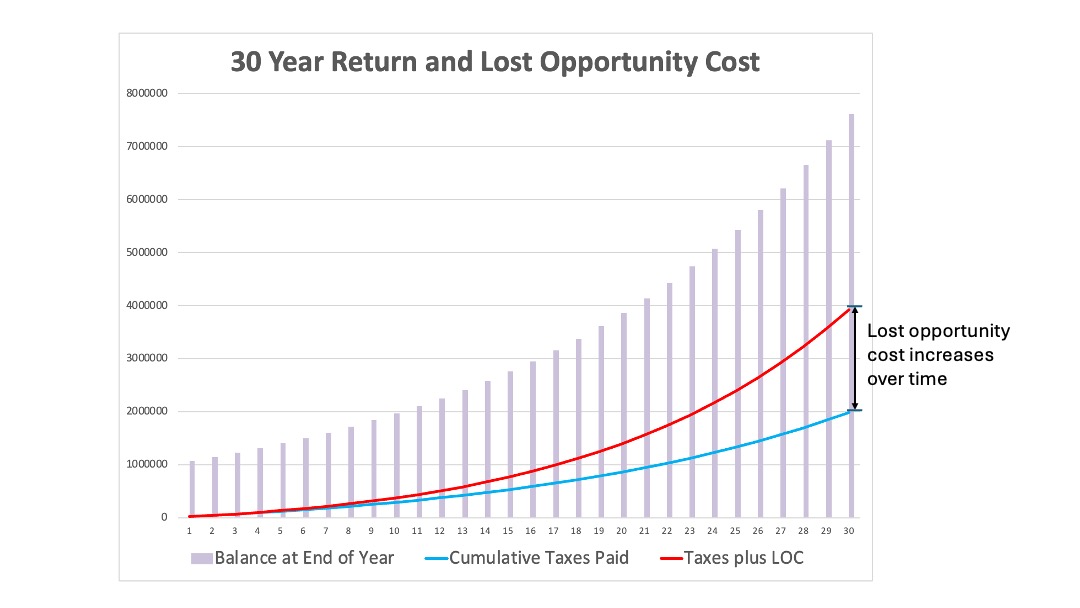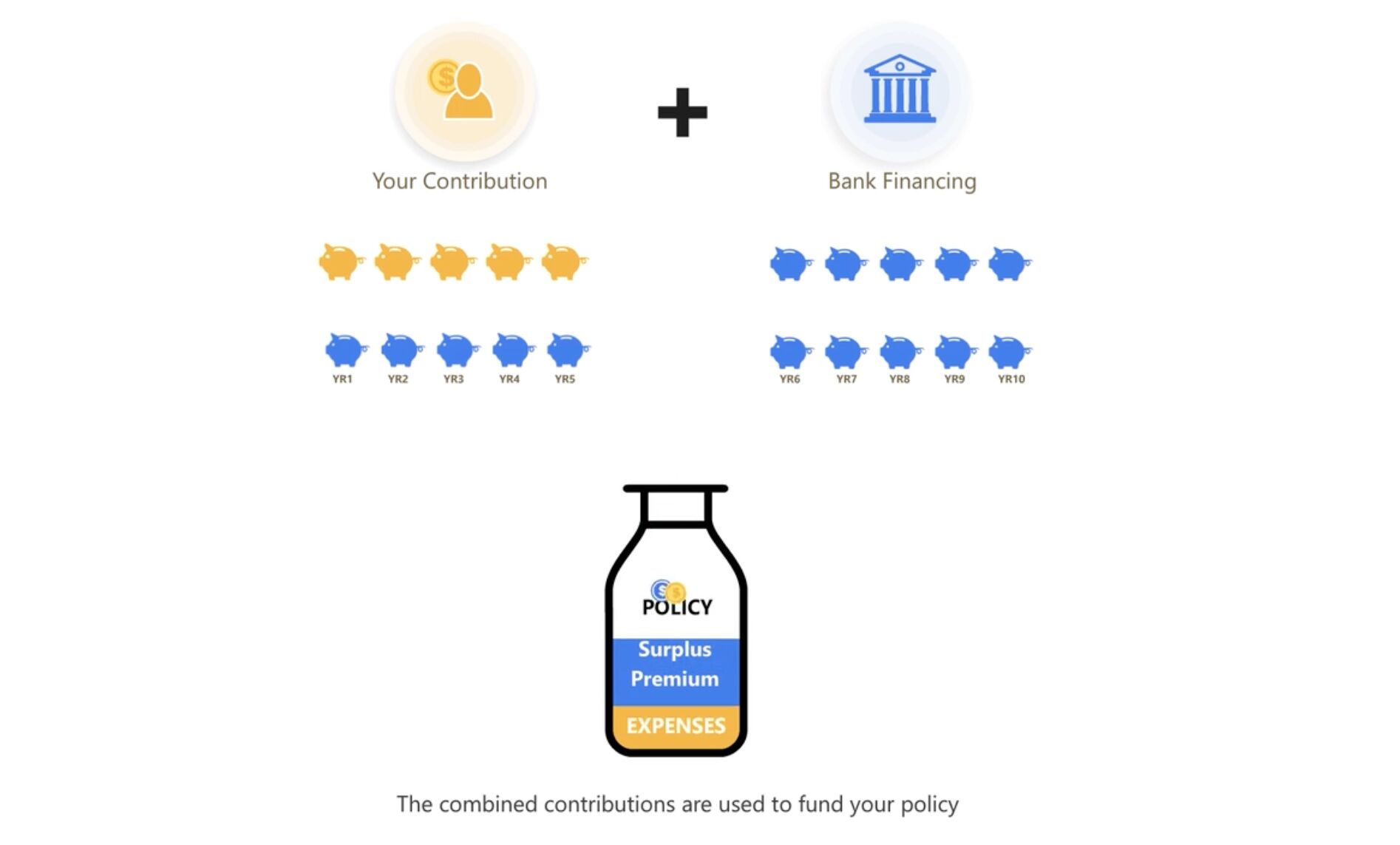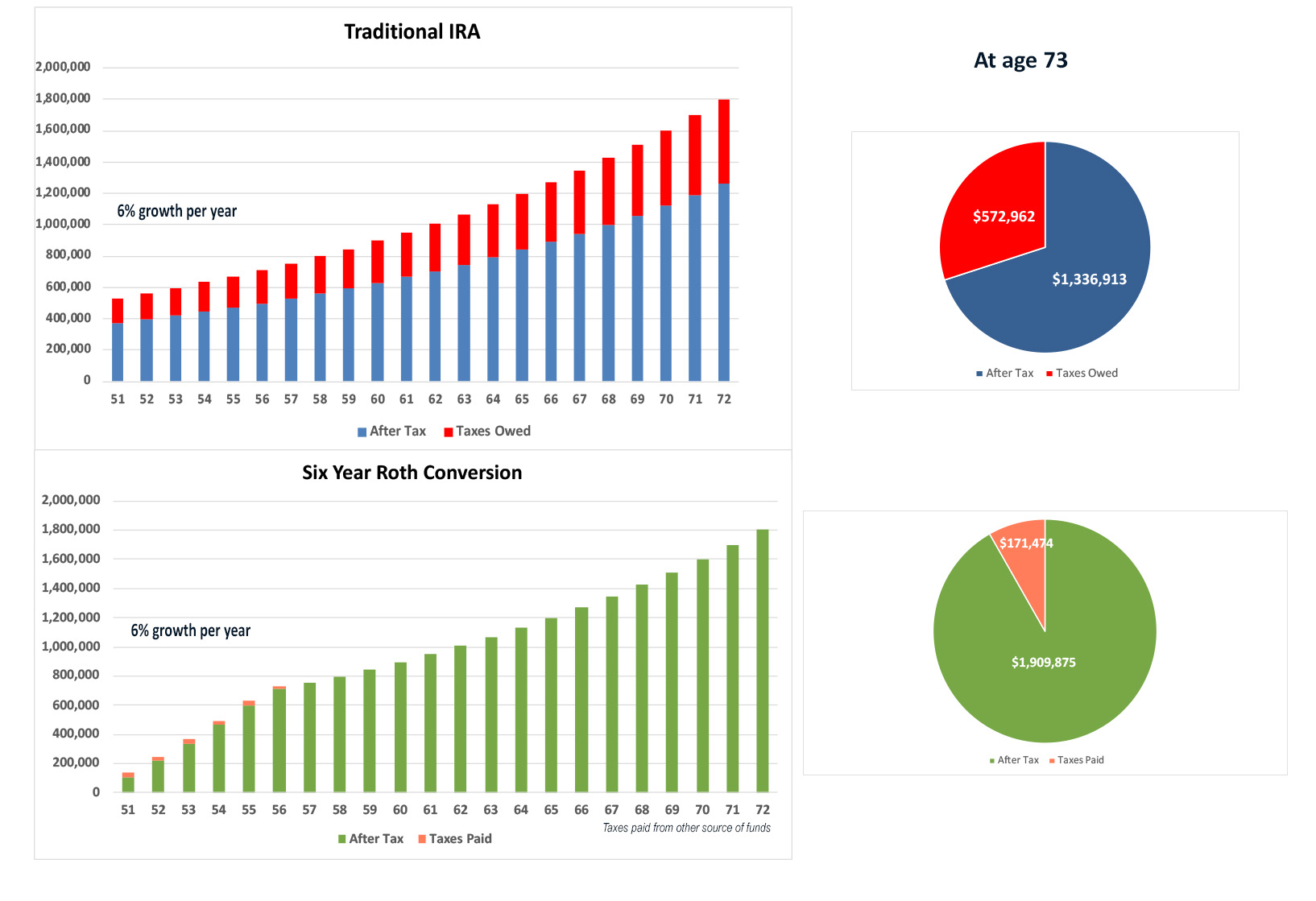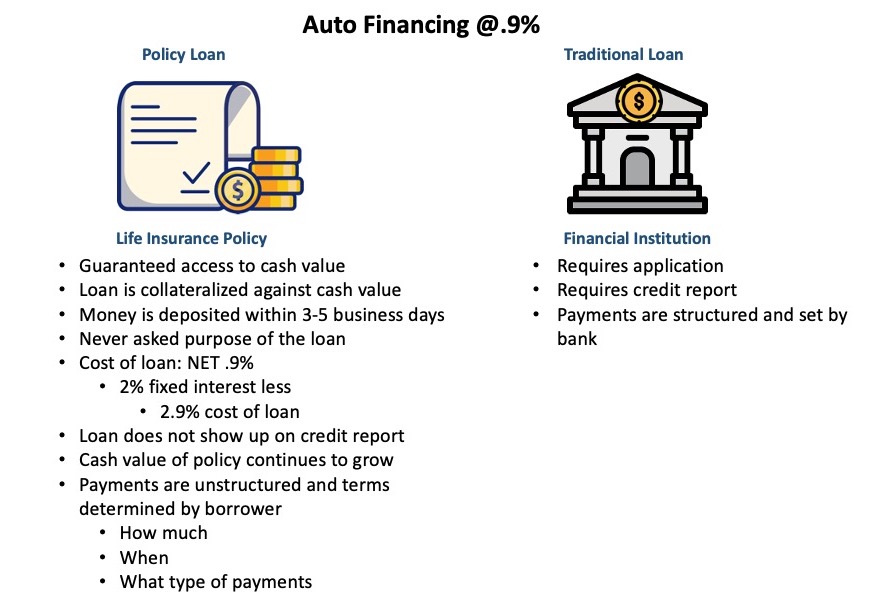The power of uninterrupted compounding is a concept to behold. A little becomes a lot, and the magic of time can make your savings grow hyperbolically. Take this example of two siblings, Jack and Jill. Jill starts putting away $6000 a year from age 18 to age 32. She then stops contributing to her savings plan. Her brother Jack starts at 33 and puts away the same amount. Even though Jack puts away a total of $360,000 over 60 years, Jack never catches up to Jill. Uninterrupted compounding allows for Jill, at 5% interest, to grow her savings to $5.1M at 93. For young people this is a good reminder to put away what you can now, so that you can live like you want to live in the future.
Money Moments
Topics and Tips For You to Keep More of Your Hard Earned Money
Saving Early Beats Saving Late
The Power of uninterrupted compounding
March 31, 2025

Your RMD: Take More and Take It Sooner
December 17, 2024
I recently had a conversation with a friend that is doing well financially. She stated that her cash flow covers her expenses and she may not even have to touch her retirement funds. Sounds great, right? Well, that might not be optimal.
Not only should she touch her retirement funds, she needs to take out MORE than the Required Minimum Distribution. Reason: by having her retirement funds “let it ride” she is not only increasing her potential tax burden, but she is also unknowingly losing the opportunity cost of taking the distribution and putting it into a a tax free asset. The lost opportunity cost is a compounded, almost to the point where the hidden cost of waiting can be as large as the cumulative amount of taxes.
Reducing the balance on her IRA means also potential tax savings on her heirs, who are required to deplete any IRA balance within 10 years of her passing.
If you are over 59 1/2, consider redirecting your IRA funds sooner to something that will be tax advantaged. Don’t wait to take your RMD. If you are under 59 1/2, there is still an opportunity to do a back door Roth rollover. As always, consult with your tax advisor before making any tax move.
Long Term Care Insurance:
Beware of the Gaps and Gotchas
July 19, 2024
Many people who purchase long term care insurance get it to ensure that their future nursing home costs will be covered. While these policies may bring some peace of mind, it’s important to understand potential gaps and gotchas. There can be uncertainty with rising premiums, new rules on what the policy will pay for, what type of facility it will pay for, as well as uncertainty of a payoff. Tens of thousands of dollars could be paying something that may not be needed. The reimbursement claim process can also be cumbersome.
There also is a waiting period, usually 90 days, so if a loved one does need assisted living, the initial costs must be borne by the individual. Even with a large policy, there are limits on monthly reimbursement amounts. This can be a surprise when it’s discovered that the monthly cost of care is not fully covered, and any gap in coverage will need to be picked up using other assets.
Fortunately there is an alternative to getting coverage for long term care, critical care that is not a reimbursement program. It also allows the individual to determine the best type of care, with no restrictions on how it’s spent, whether it’s in home care, residential home care, or in a facility. I set this alternative up for myself, and it affords my family options to provide the best care for me in my final days. This provides a simpler approach to getting a long term care solution. Medical expenses are the No. 1 reason why seniors go bankrupt, so it’s important to have a plan for this.

What is Your Long Term Care Plan
June 28, 2024
I recently ran across a family that had an aging parent.This parent can no longer live independently. Unfortunately, she distributed all her assets (including the house) to her children and does not have the resources for any assistance, whether it’s in home care or at a facility. Her children are not volunteering to step up to the plate. One adult child, who has a full time job working remote is now caring for her, but the situation is really tense. There is no medical professional dedicated to managing the care of the parent , nor anyone with the skills to identify any signs of declining health. Any move requires the family meeting between the siblings for either care or money. All are stressed, but mainly the mom from being in an unfamiliar surrounding, and the caregiver who is juggling two large responsibilities. This stress while under the surface, can suddenly manifest itself in an unpleasant way. It is an unfortunate situation for all parties, but mainly for the mom, who spent all her years raising a family only to end up living her last days in suboptimal care.
The above story illustrates the importance of taking charge of your long term care. With the cost of care averaging $10,000 to $15,000 per month today, it’s also important to set aside enough money for 3-5 years of care. There are several options to secure a plan. One of them is a life insurance policy with critical care and long term care riders. It is not a reimbursement program, and can be used it for in home care, adult day care, or at a live in facility. I set one up for myself, and told my children that if the time ever came where I could not take care of myself, there will be funds to set me up in a nice facility (no linoleum floors, and no fluorescent panel rooms please). It’s important to 1) make your long term care wishes known and 2) make sure you have enough finances to live the rest of your life in comfort with the proper care professionals.
If you don’t have a long term care plan yet, let’s talk. Don’t leave how you want to spend your last days to chance.
Case Study: Using Leverage to Supersize Your Policy
May 30, 2024
In my last post I talked about how one can supersize their insurance policy using OPM (Other People’s Money) at a 3:1 match. I recently looked at a case for a 29 year old engineer. She was saving a lot and I showed her how she could contribute $50,000 a year for 5 years and a lender will match it 3:1, giving her $919,000 of premiums to fund a policy. The policy provides protection and a vehicle to grow cash tax free. The result: An initial policy of $2.483 Million. When she turns, 65 she can tap into an annual tax free distribution of $292,000 until she turns 90, That amount at a 30% tax rate is the equivalent to a $417,000 job. Of course she can also access the money in her policy before 65. If you are interested in seeing how this money strategy can work for you, hit me up. Happy to help you get leverage and get more tax free cash flow.

A Tax Recovery Strategy
May 8, 2024
Besides our mortgages, taxes will be the largest expense of our lifetime. And with tax rates expected to rise, more of your hard earned dollars could be going to pay taxes, meaning less take home pay for you. But there is a strategy that can recreate the value of what those lost tax dollars have taken. Using leverage and a cash value life insurance policy (for tax free growth), an individual earning $400K per year can contribute $65K a year for 5 years, and potentially earn $2.8Million through policy loans. It sounds too good to be true but the use of leverage is a strategy well know to high net worth (over $10M in assets) individuals. But unlike traditional leverage, the Kai-Zen strategy does not require underwriting for the leveraged amount and you do not have any liability outside of the 5 years of payments. Learn more here by watching this short video: https://lnkd.in/gzKiY_bP.
This strategy can also be used to supersize any inheritance you plan to leave. I have personally set this strategy up for my adult children who are now 23. More on this wealth transfer strategy later. If this is intriguing to you, let’s set up a time to chat.
Roth Conversions
April 24, 2024
Another tax season is behind us. Did you take a look at where you landed within your tax bracket? This is important if you are considering doing Roth conversions, as there may be some “headroom” to pay incremental taxes without crossing into a higher tax bracket. Given that taxes have to be paid upon retirement account withdrawals, there might be an opportunity to pay taxes now before they are expected to go up in 2026. Talk to a tax planner (not necessarily your CPA) before making this move. Your tax planner can look at 5 year and 10 year horizons to see what your tax obligations could be and if Roth conversions make sense. #taxes #Rothconversion #taxplanning
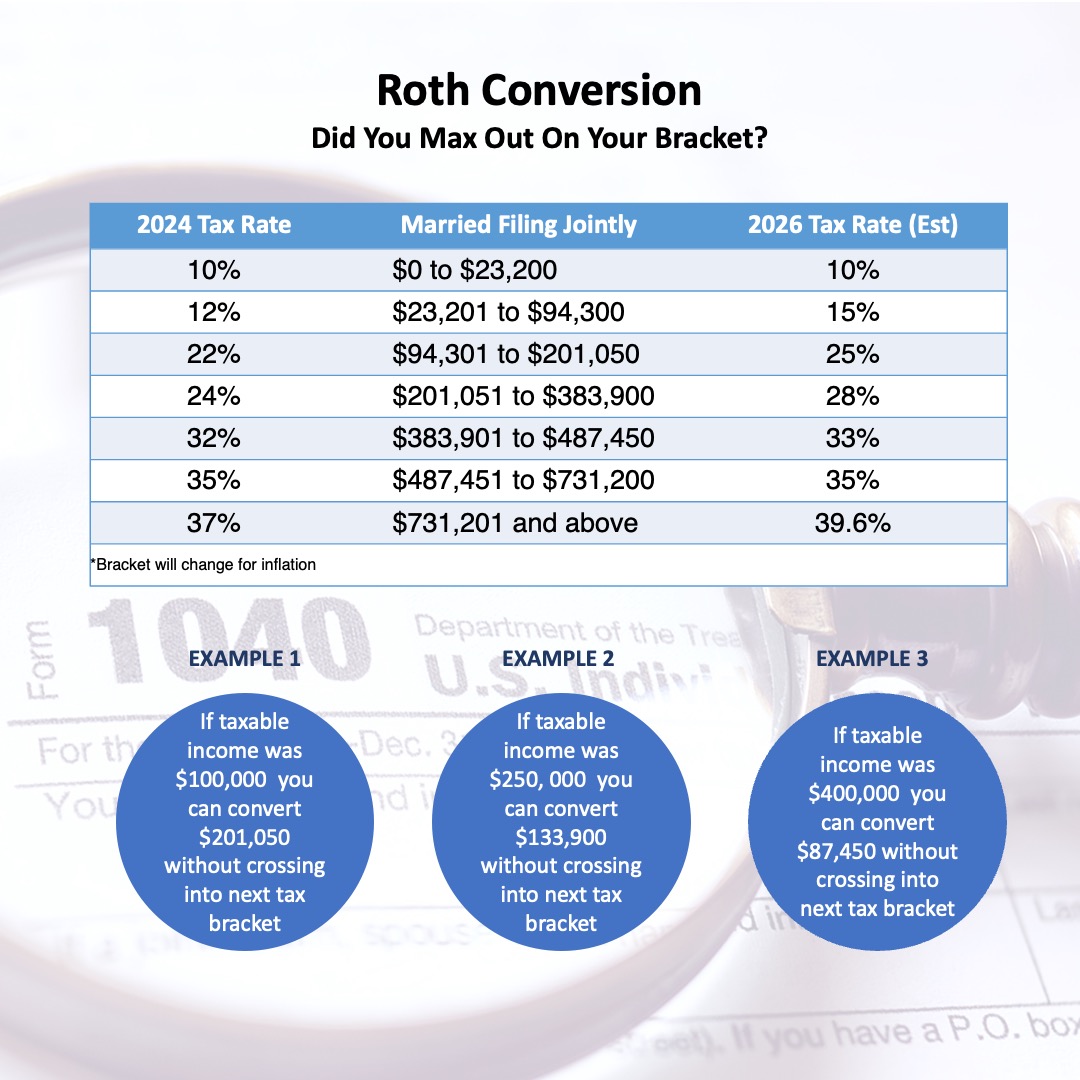
Consider a Roth Conversion
December 1, 2023
As 2023 draws to a close, here is a money move that can keep more money in your pocket. Many of us have traditional IRAs that grow tax DEFERRED. As the balance grows, so does our tax obligation. But if we take a look at doing a Roth conversion, with taxes paid off, we can let our next egg grow tax FREE and get more certainty about how much money we have for retirement.
Take this example of Jill, a 50 year old woman that has accumulated $500,000 in an IRA. At a 30% tax bracket the taxes can grow to $572,962 before any required distributions at age 73. If Jill begins converting her IRA to a Roth IRA over six years, Jill would have paid the taxes up front so that her nest egg can grow tax free. When Jill reaches 73, she is not required to take any distribution, but if she does, she does not have to pay any taxes, as they were paid already.
Her Roth IRA is also protected from any future tax increases. This is not so with a traditional IRA: If taxes go up, so does the red slice of the pie. And should Jill pass away, her heirs will get an inheritance without any impact to their taxes. Again, not so with a traditional IRA. Her heirs will have additional income that could expose themselves to a higher tax bracket and higher taxes.
While Roth conversions offer compelling advantages, it’s important to assess them alongside your current and future tax situation, as well as your financial goals. Consult with your financial advisor or tax professional before proceeding with a conversion.
What is Your Financial Legacy
November 9, 2023
Many clients that have achieved financial success now want to help their children. What should they leave their children and grandchildren? How do they ensure their monetary gifts will be spent wisely and last? In today’s world of high consumption, a lump sum inheritance can be gone in the blink of an eye.
Fortunately there is a way to provide a lasting gift that creates financial security: a tax advantaged income stream that can be available to your children and grandchildren for their future needs. This program also provides you control so that this gift can last their lifetime. If you are interested, send me a DM and I can show you the possibilities and what I personally did for my adult children. Another bonus: these funds are protected from access by creditors and community property.
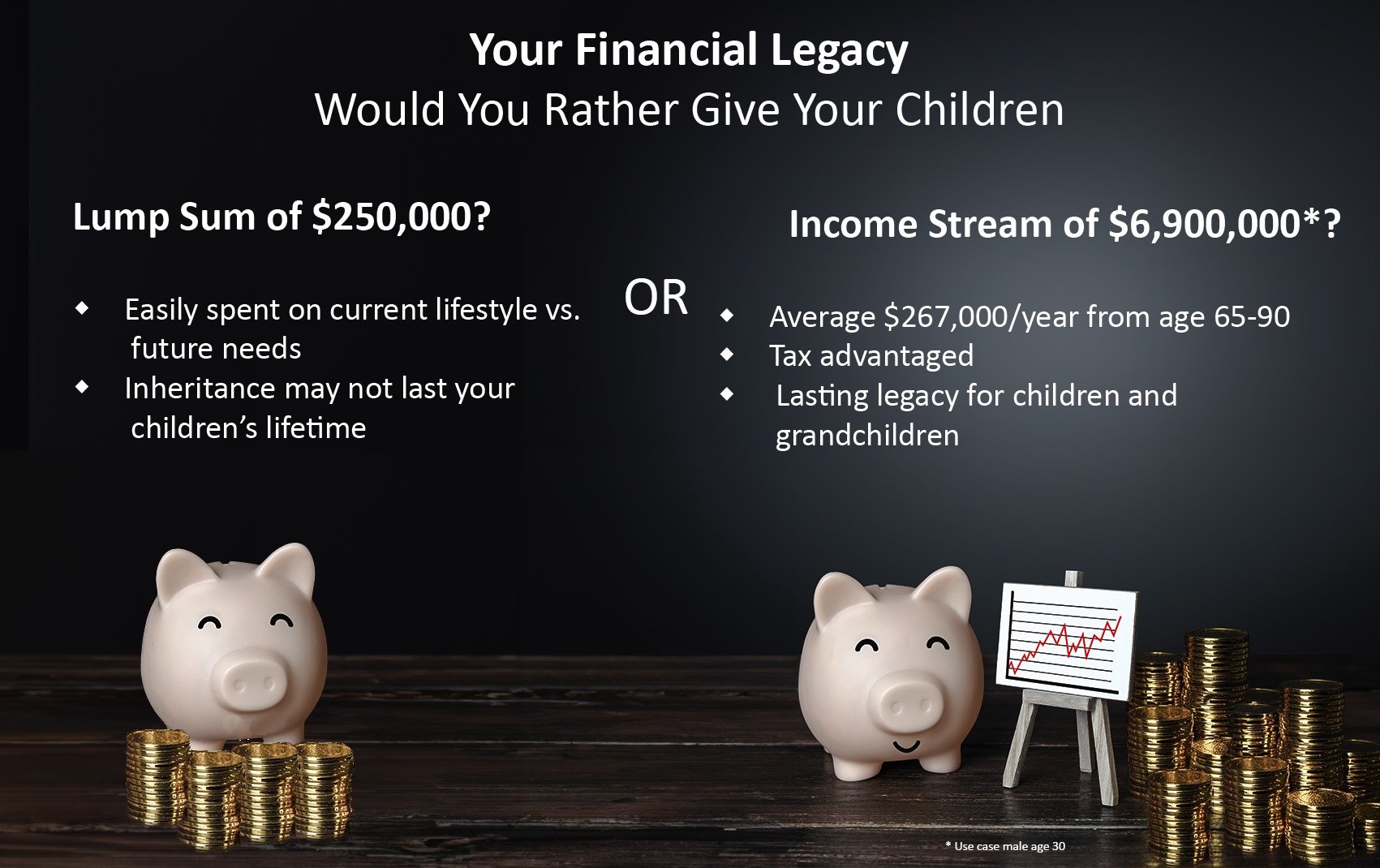
How I Saved $10,000
October 31, 2023
I recently had a car loan that had an interest rate of 5.9%. That would mean $10,000 in interest payments over the lifetime of that loan. To save money on the interest, I decided to tap into the cash value of my life insurance policy, pay off the auto loan using the proceeds. The process was quick and I never was asked why I needed the funds. As long as there was cash value, I could borrow against it. The cash in my policy still earned interest, and resulted in a net cost of borrowing to be .9%. Best of all, I could determine how to pay back the loan: either in monthly payments or bigger chunks at a time. Policy loans are often used by real estate investors as a means of quick access to cash. Take a look at your own policy and see if there is some cash value. It might be a good source of funds for expenses, emergencies, or even investments.
401K Loans: A Case Study
October 4, 2023
Is taking a 401K Loan a good idea? You are paying interest to your account after all. Access to cash can be quick. But what is the impact in the long run? Here are some things to consider.
- Interrupted Compounding — The borrowed money loses the potential benefit of compound interest—a crucial element of long-term investment growth. In addition, there are some 401K plans that will prevent you from from making 401K contributions until your loan is repaid. If your plan has a company match, you can also be missing out on this key benefit.In this case study, Bob has $100,000 in his 401K and contributes $10,000 per year in his 401K. He needs to borrow $50,000 and plans to repay it in 5 years. His 401K balance in drops from $100000 to $50000. His plan prevents him from contributing while he has a loan, so he no longer can add $10,000 per year to his 401K. His payments and principal do go back into his account each year.Because he gave up uninterrupted compounding, he has to build his balances starting at a lower level, even with a loan interest that is higher at 9%. After 20 years, his loan would have resulted in a lost opportunity cost of $163,500.
- Repayment is with After Tax Dollars — Like any loan, repayments are made with after tax dollars. Bob’s loan total principal and interest payments over five years are $61,374. At his 30% tax rate, he would need to gross $87,377 to pay back the loan.
- Double taxation— Interest payments with after tax dollars will be taxed again upon distribution. In this case the interest of $11,374 will grow and be subject to taxes again. Bob paid tax once on the interest, and when it got put back into the 401K it will be taxed twice upon withdrawal.
- Taxes and penalties for non payment — Should Bob lose his job after 1 year of loan payments, the balance of the loan may be be due and paid within 60 days. If he cannot pay the loan, the outstanding balance will be considered an early withdrawal, be taxed and subject to a 10% penalty.
401K loans are complicated and the rules can vary from company to company. They can work under certain conditions, such a short term bridge loan. It’s best to be informed so you can make the best decision for your situation. Please consult your financial advisor before you make any decisions
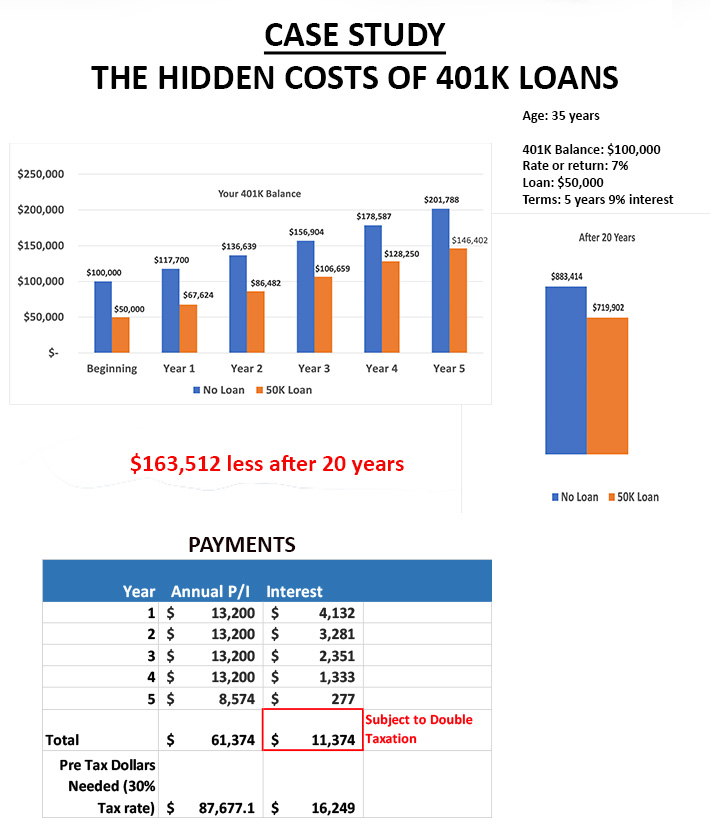
Don’t Live a “Just in Case” Retirement
September 28, 2023
You’ve worked hard and achieved many career successes. Make your retirement years just as successful. Don’t live a “just in case” retirement where you are afraid of spending. There are tax-free income streams and lifetime income tools that ensure you won’t outlive your money. Once you have tools that can have a guaranteed source of income that will last until your death and the death of your spouse, you can afford to live your dream, and be more giving and generous. Make your retirement years your best lifestyle years.
Take the Money or Take the Distribution?
July 20, 2023
Americans who are over 59 1/2 and who have purchased an eligible electric vehicle now have another decision to make: do we take the tax credit and pocket it, or do we make a move to take an IRA distribution? While taking the cash provides immediate gratification (who doesn’t love that), taking an IRA distribution might save you more money in the long run. In the example below the $7500 tax credit translates to $26,786 of income at a 28% tax rate.
Let’s say we don’t take an IRA distribution and our future tax rates go up by 4% to 32%. If we take the same distribution of $26,786 from our IRA, our taxes at 32% will be $8571, resulting in an additional $1071 in taxes. That’s less money in our pocket. The choice for you depends largely on 1) the need for the cash flow and 2) if you believe taxes will be the increasing in the future. For me, I’m going to take an IRA distribution to get that chunk out free from federal taxes. Doing this requires some planning, as I don’t want the distribution to push me into the next tax bracket. Ultimately you will need review your move with your tax accountant. #taxcredits #taxes #retirementaccounts #IRAs
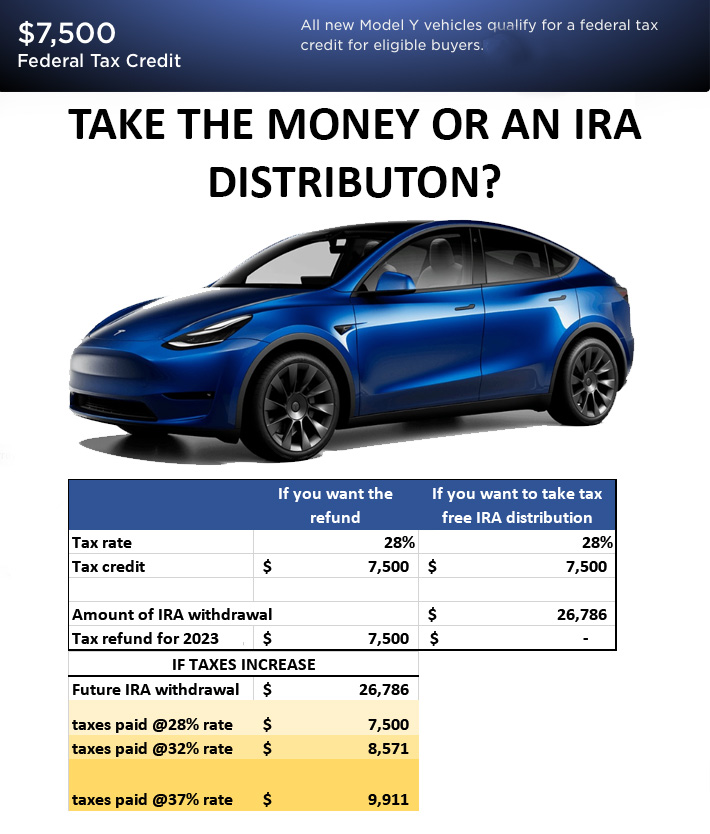
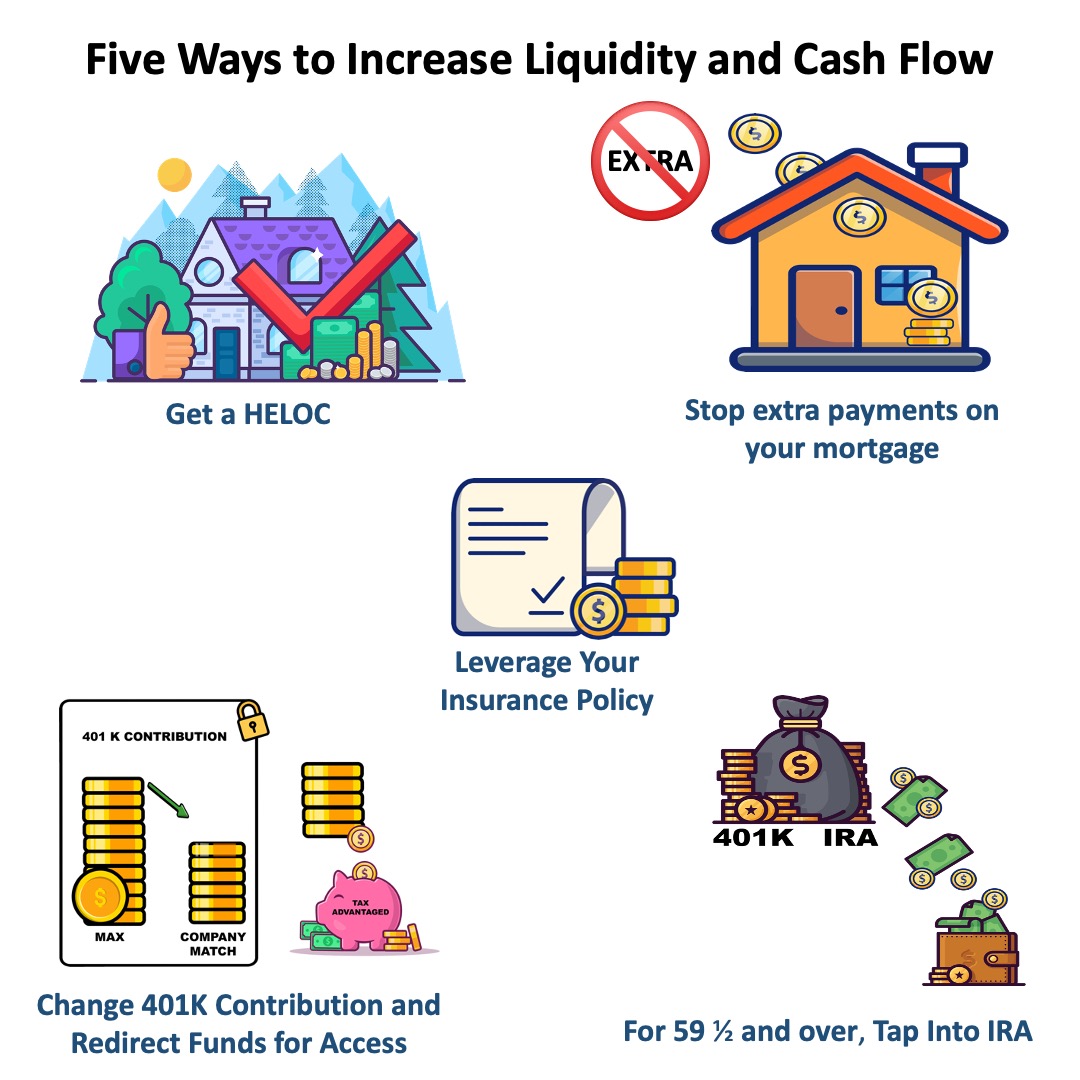
Increase Your Liquidity
June 1, 2023
Last week was a rough week. Some of my former colleague were laid off, some survived a layoff, and some had the unfortunate task of doing the layoff. With the economic uncertainty, having liquidity and cash flow is paramount. Here are some things that can be done to increase cash flow and give you more of a cushion:
1. Get a HELOC — If you are still working and have sufficient home equity, consider applying for a Home Equity Line of Credit (HELOC). Most HELOCs can give you access to cash to weather loss of employment. Since most banks utilize income as a deciding factor in a loan application, it’s best to get one while you are working.
2. Stop Extra Payments on your Mortgage — If you are making extra payments on your mortgage, consider redirecting those payments in a safe money market fund that only earns interest, and gives you access to the money should you need it. Extra payments to a mortgage only lock up your cash and ability for that cash to build compound interest.
3. Leverage Your Insurance Policy—If you have a permanent life insurance, look at the cash balance of your policy and borrow from your insurance company. The insurance company will typically lend you up to 95% of your cash value. No questions asked. Cash is available within 3-5 business days. Best of all, because it’s a collateral loan, the cash in your policy continues to earn interest uninterrupted. Extra bonus: any loan repayment will be on your terms. And you even have the option of not paying it back.
4. Slow roll your 401K contribution — Instead of maxing out your 401K consider contributing only up to your company match. The rest can be put into a tax advantaged account that earns interest and allows you access to the cash should you need it.
5. Tap into your retirement funds — If you are over 59½, you can take a distribution from your 401K, 403b, IRA, SEPP to replace any lost income. Consider taking not just the required minimum, but take enough to not hit the next tax bracket and redirect those funds into a tax free account.
In these days cash FLOW is KING. Reach out if you have any questions or comments. Always happy to help.
Lost Opportunity Cost
May 3, 2023
With Secure ACT 2.0 pushing out the age for required retirement account withdrawals from 70 1/2 to 73 (or 75), many retirees will opt to “let it ride” and delay taking funds out of their IRA, 401ks, 403bs, or SEPPs. But did you know that when you delay taking a withdrawal, not only does your tax obligation grow, but also the lost opportunity cost of paying the tax early, and redirecting the proceeds into a tax advantaged account? Redirecting the funds earlier could mean keeping more of your hard earned money.
Take this example of a $1M balance of an IRA fund. After 25 years earning 8%, there will be $1.6M of tax (37% rate) due. If there was no withdrawal, not only are there taxes, but also $1.3M of lost opportunity cost by not taking action. Also because the lost opportunity cost is cumulative, in later years annual lost opportunity cost can even surpass the annual tax.
The above example is extreme, but intended to highlight a hidden cost in the funds that many of us rely on for retirement. The longer the delay, the bigger the tax obligation, and the bigger the lost opportunity cost. As always please consult with your tax advisor when making decisions that can have huge financial impact.
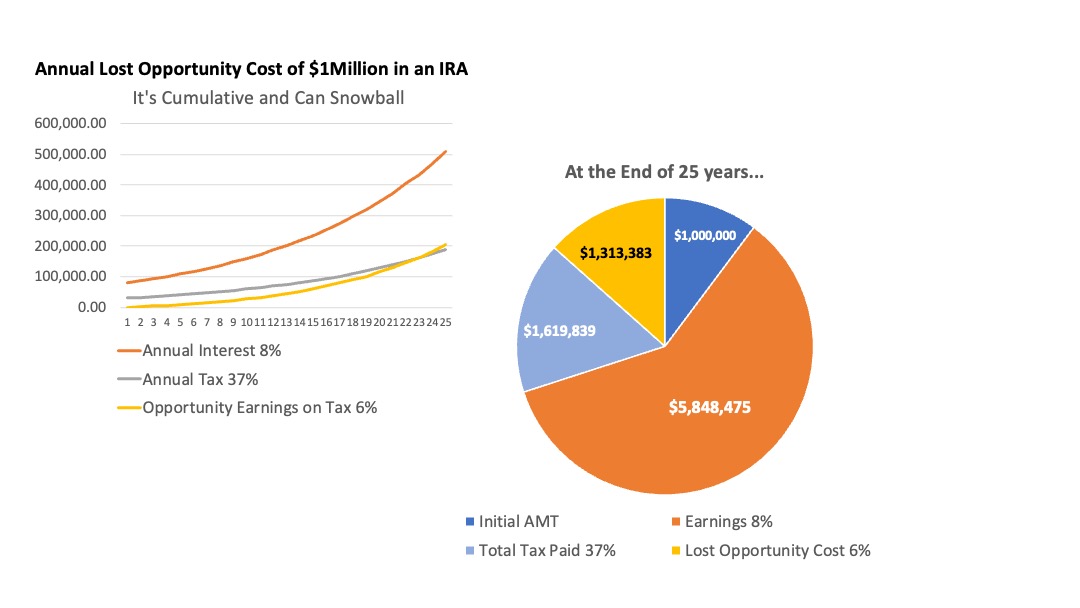
Minimize the Tax Surprise
April 6, 2023
Many folks planning on retirement mistakenly believe they will be in a lower tax bracket when they retire.
However, in retirement they often discover that their taxes did not go down as expected, even if their income was lower. Why? the income from their IRAs, pensions, Social Security benefits are all taxable. But if the house is paid off, there is no interest deduction, nor are there any deductions for their children, who are now adults.
And let’s not forget that our government can decide to raise taxes, which means that your share will be less that previously planned for. Fortunately, there are ways to minimize the tax surprise. If you have a large 401K, 403B, TSP, or IRA, you can shift your money to tax advantaged income streams. Ask me how. I’m always happy to help my clients keep more of their hard earned money.
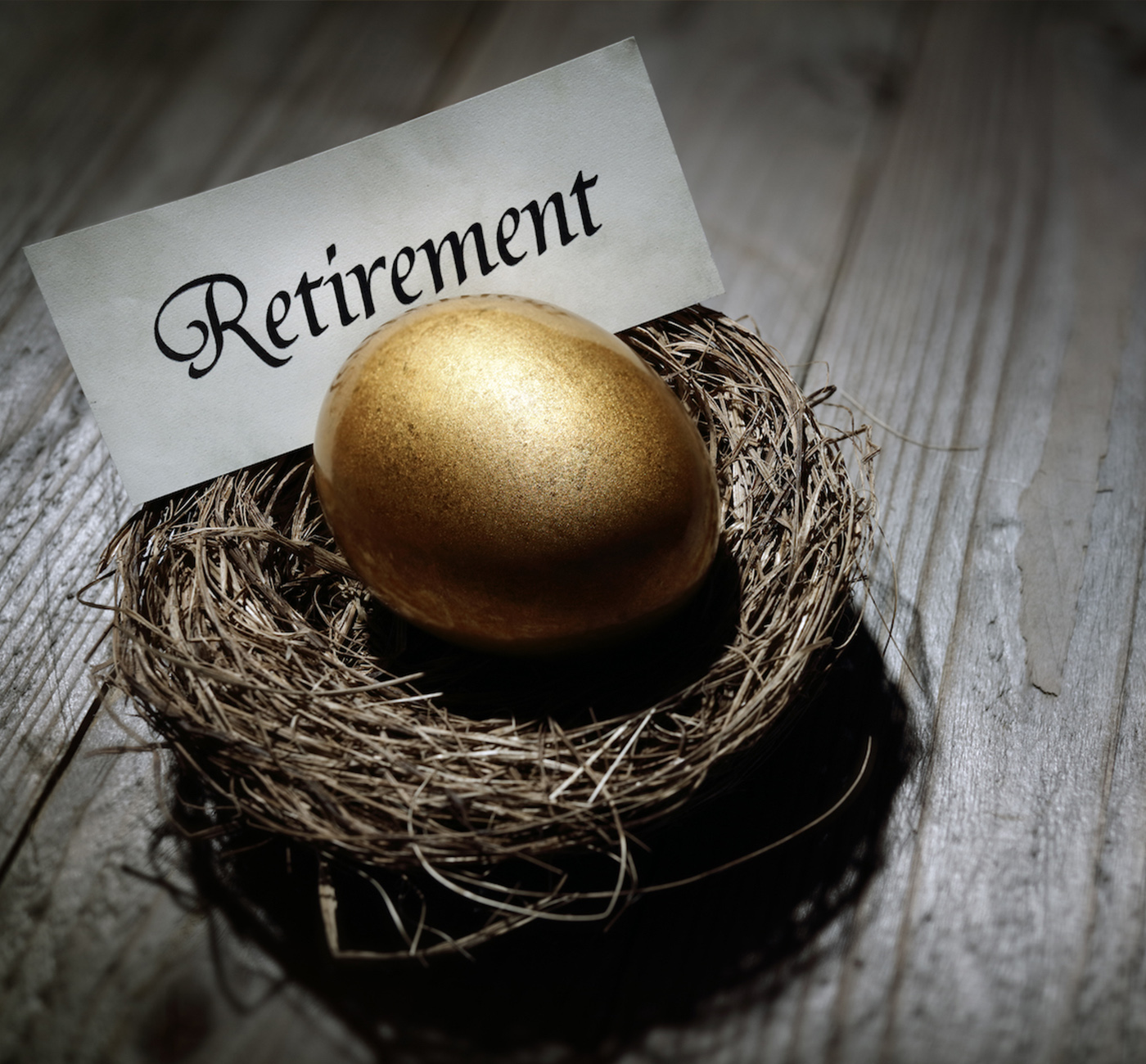
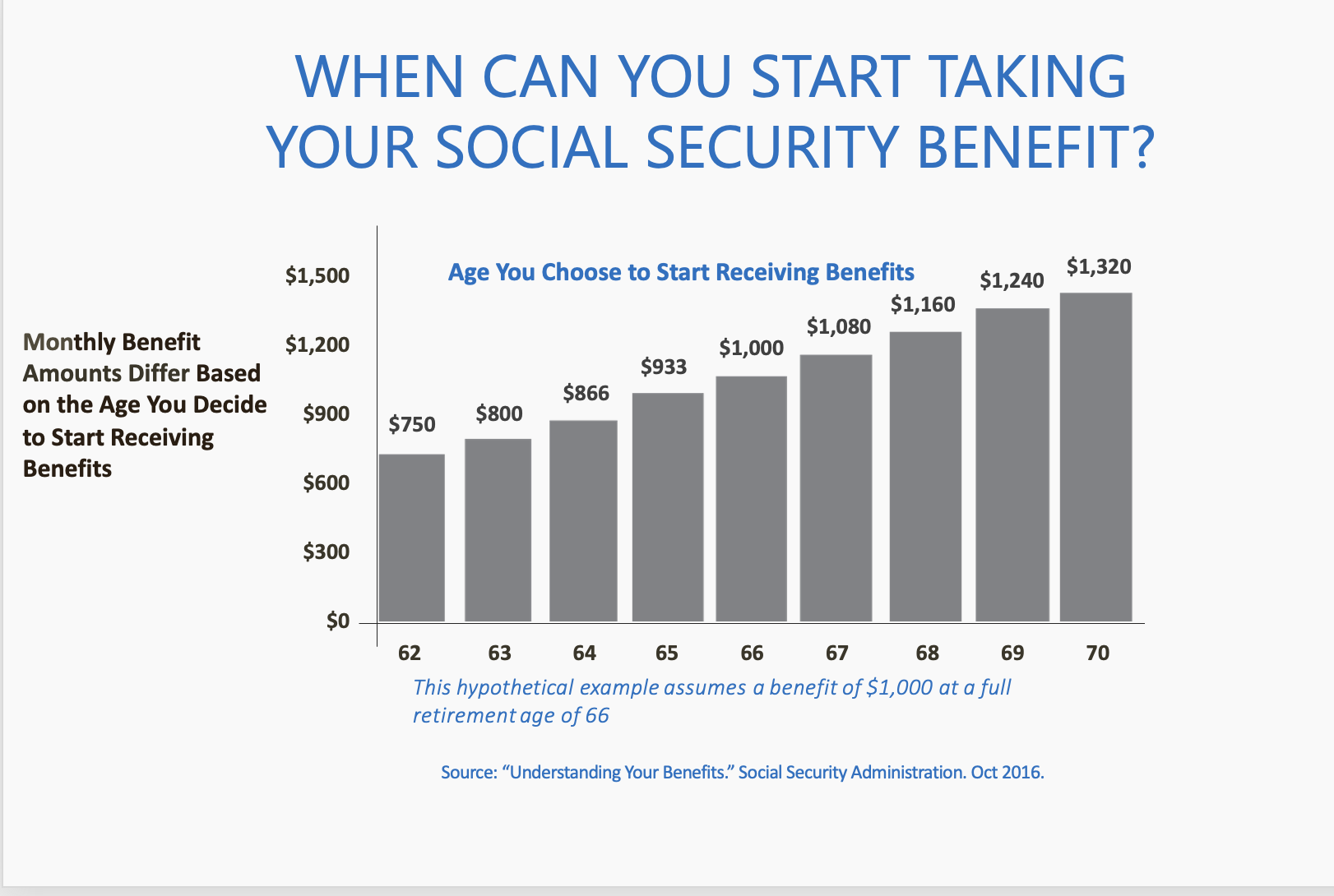
62, 67, or 70?
March 22, 2023
When should you start taking your Social Security benefits? There is no clear cut answer as each person’s situation is different. Does longevity run in your family? Do you need the money or are there other sources available? Will you continue to work? If you take your Social Security benefit at 62, your monthly check will be reduced by 30%. And if you work and make over $21,240 in wages your benefit will be cut in half.
After you reach full retirement age (FRA) the work limitation is lifted. You then can decide to take your benefit or wait three more years to maximize your benefit. Each year you wait is an 8% increase in your benefit. Some may take the money at 67 and invest it, but these days an 8% return may be a challenge to achieve.
For my situation, I plan to wait until 70. My parents lived until their 80s and 90s. I have other monies set aside. But that’s me. Your situation may be different. If you would like some help to figure this out, please reach out to me. Happy to help you get more of the benefits that you have paid into.
Know Your Solvency Rate
March 16, 2023
The recent fail of Silicon Valley Bank has many people skittish. We’ve seen in the news how banks, which traditionally have been viewed as safe places for money, are at risk for not having enough cash reserves on hand. Moody’s has also downgraded the banking sector and placed six banks on their watch list.
While banks are only required to have a fractional reserves (minimum 10%), insurance companies are required to maintain a solvency margin, the amount of cash and assets compared to their policy liabilities.
Insurance companies are also more closely regulated than banks.This requirement for insurance companies to maintain sufficient capital and reserves is intended to protect policyholders.
Typically, insurance companies have a solvency rate of 1.2 or 1.3, meaning for every $1.00 of potential claims, the company has at least $1.20-$1.30. One insurance company has a solvency rate of 1.99. These rates can provide some assurance regarding the cash in your life insurance policy
While insurance company failures are rare, having a solvency margin over 1.00 mitigates that risk. If you have a cash value life insurance policy, it might be a good idea to check your insurance company’s solvency rate.


Write Your Love Letter
February 14, 2023
Valentine’s Day is a day for many to express acts love. Candy, flowers, jewelry, or a nice romantic dinner. Another act of love to consider is a love letter, but this one is to be opened after you have left this earth.
Your letter can express your love for your family, and final words of encouragement, and advice on how to manage the resources that will be coming. I often advise my clients to write one and put it alongside their life insurance policy.
Another act of love is to leave a financial directives document: the location of all the accounts and other assets. When my husband passed, we had to figure out where all the money and assets were, which compounded our grief.
These two things, your love letter and financial directives document are true acts of love and care for your family.
If any of you would like a template to jumpstart the process, please reach out.
p.s. don’t forget to leave your cell phone pass code as well.
Insure Your Kids Instead
February 9, 2023
I have some clients that currently do not qualify for life insurance. This can be due to their age, but more likely, it’s due to their recent health conditions that have emerged. This is why it’s best to get permanent life insurance when you are young, as the likelihood of health issues such as high blood pressure, diabetes, heart conditions etc, happening at a young age are low.
We can look back at my previous example with Janet, age 55 with $200,000 that she wants to leave for her four children. She can leave life insurance, which can result in a $600,000 death benefit. But due to some health issues, she cannot be insured.
An alternative strategy would be for Janet to take out policies on her children. Given their ages in the illustration, the range in the death benefit would be from $450,000 to $548,000 each.
Janet still controls the policy: she can determine the beneficiaries, changes the beneficiaries, and access the cash value that is being accumulated.
Upon her death, Janet can stipulate a new owner of the policy. Usually it will be the insured. This is another way to transfer wealth to the next generation.
If you are thinking of leaving a legacy to your children, other heirs, or a charity, let’s talk. We can design something to meet or exceed your goals.
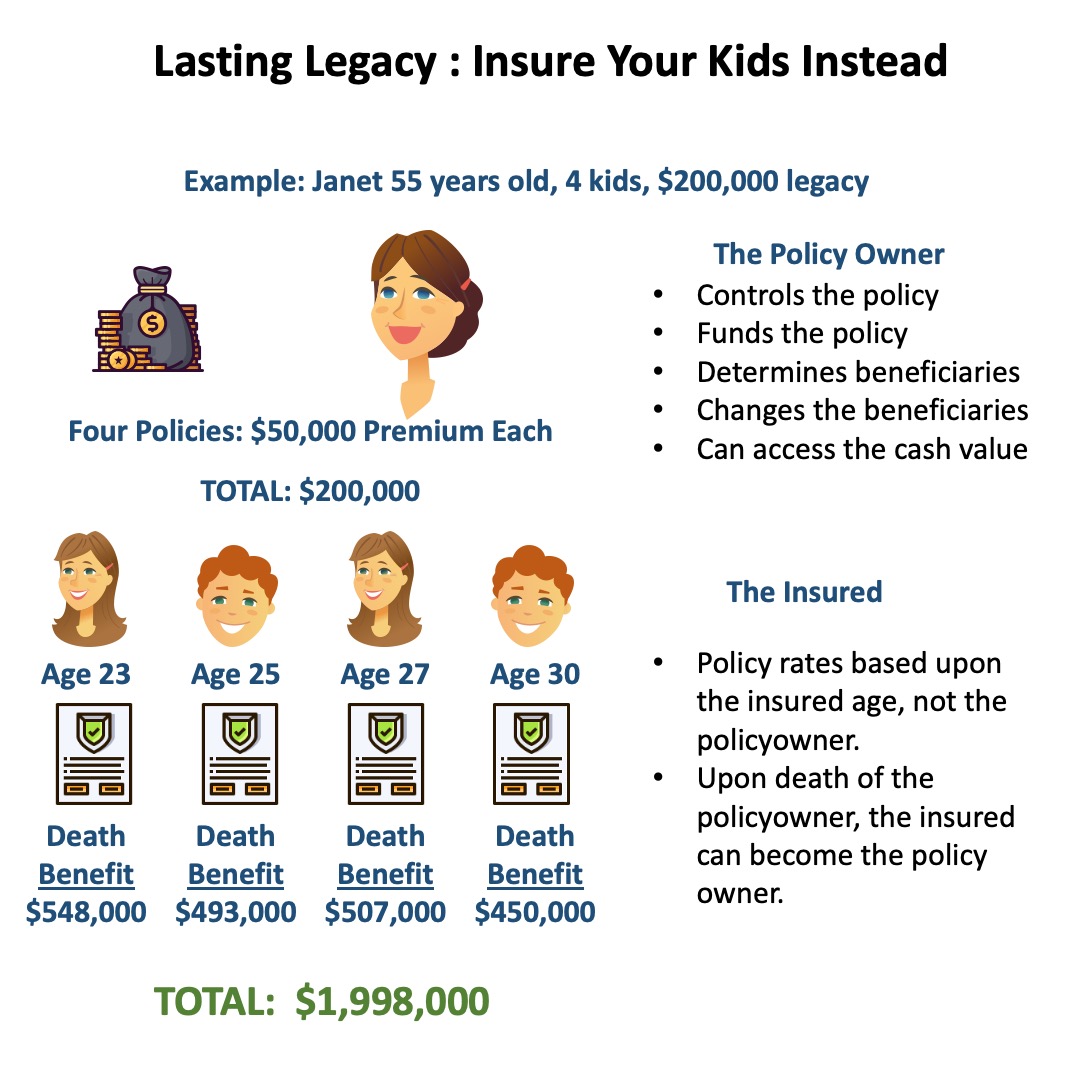
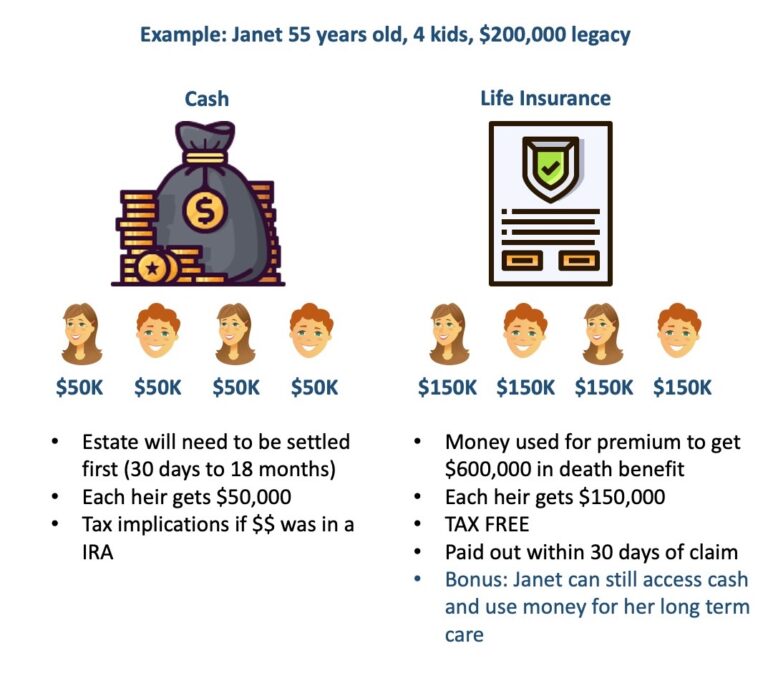
Don’t Leave Money to Your Kids
February 1, 2023
As in my last post where I talked about the permission to spend your hard earned money, another area to think about is what type of asset to leave the kids. An asset that will create tax free wealth for the next generation, while allowing you to enjoy the retirement lifestyle you worked so hard for. Did you know that a well designed life insurance policy can do just that?
An example is Janet, 55 years old with four children. She has $200,000 in cash that she wants to leave her four children. Each heir will then get $50,000. But if she applied that $200,000 into a life insurance policy, she can get a $600,000 life insurance policy. Upon her death, each heir will get $150,000. That’s 3X what she could do for them with cash.
Janet also can access her cash value at any time to further her lifestyle and use the policy for her long term care needs should she require it. With this example, life insurance can be one of the most efficient vehicles to create and transfer wealth. Ask me how I can design a policy for your needs.
Permission to Spend
January 26, 2023
I recently received an inheritance from my father’s estate. While I am grateful for this gift, I think about all the sacrifices he made working 12 hours a day 6 days a week to run our family restaurant. Unlimited PTO was out of the question for him. Career satisfaction? Not even top of mind. As an immigrant, his main goal was to make sure his family had a roof over their heads and food to eat. Even after seeing his daughters have successful careers. I wish Dad treated himself more with more travel and other luxuries. He deserved it. I will always be grateful for his sacrifices.
For my clients that are planning retirement, I often ask them what they plan to leave for their children or other heirs. Usually it’s the house or some other asset. This then gives them the flexibility to spend the rest, provided they have a plan for major medical and/or long term care. You do have permission to spend your money. Go ahead: live a great retirement, go on those trips, buy that 1st class ticket, get that ocean view room, and be generous with your giving. If you don’t know if your money will last, hit me up. You can overcome fear of the unknown with income and expense projections. Live your best life, in the 4th quarter of your life.

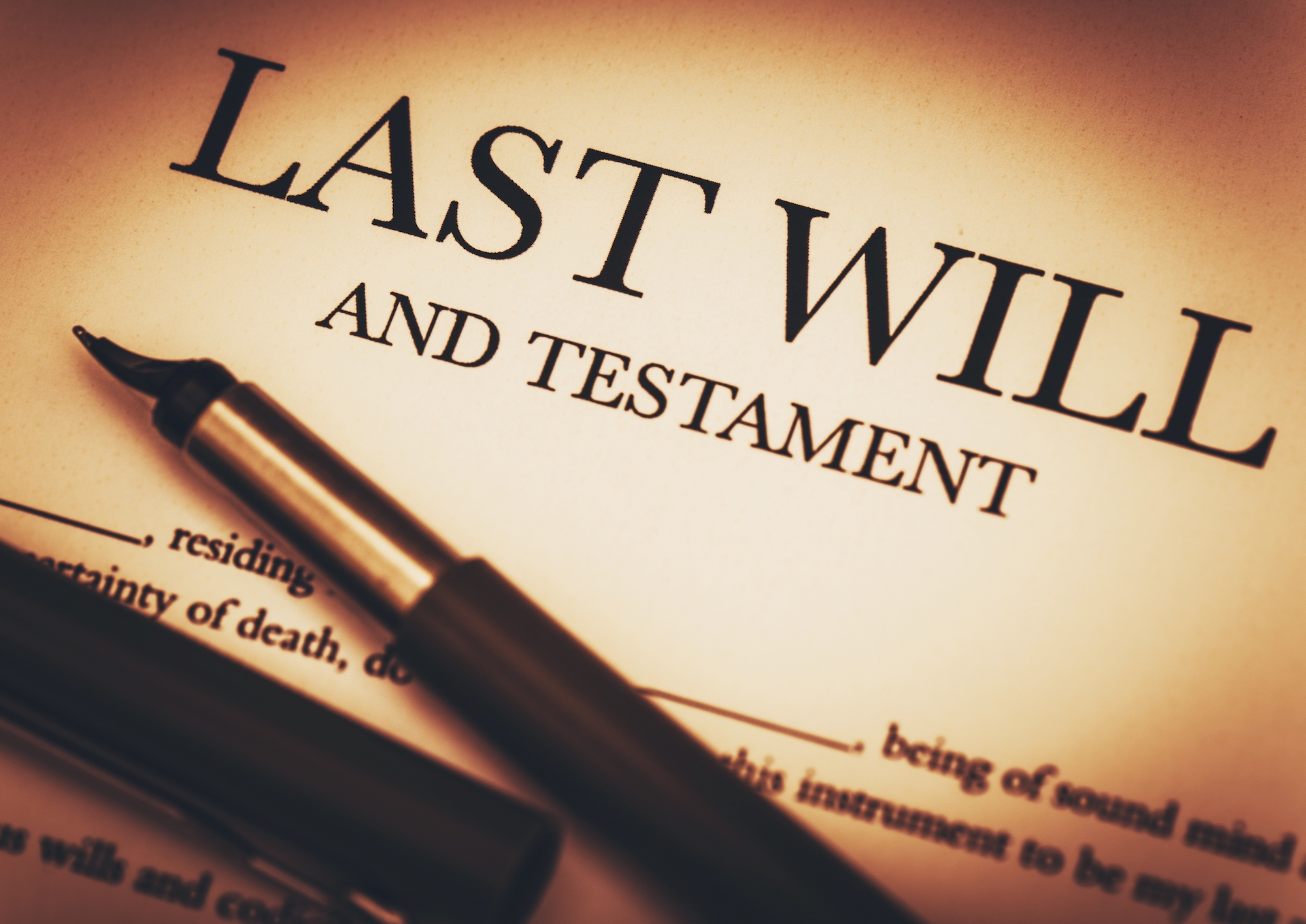
Wills, Trusts, and Beneficiaries
January 19, 2023
With the passing of my father and my mother in law in July, as well as the passing of my father in law in March, I haven’t been posting much. Going through grief and managing their estates have taken a lot of time, not to mention energy. As my family is going through cleaning out their house and closing out their trusts, it’s important to revisit those documents every 3-5 years.
If you don’t have a will or a trust, you may want to get one. Otherwise it can take as long as 18 months to go through probate or to get a small estate affidavit. When my husband passed we had not set up our trust, and the cost and time was lengthy.
If you do have one, take a look and make any updates as needed. It’s important to update other things so that more of your hard earned money does not go to taxes.
p.s. don’t forget to review the beneficiaries of all your financial accounts too. that can be subject to court proceedings
How to Buy US Treasury Bonds
July 14, 2022
Top of mind for many of my clients is inflation which is now at 9.1% as of June. With the uncertainty of the markets, they are also asking where they should be investing. One investment to consider is a US Treasury I bond, which is now offering a 9.62% interest rate for 6 months. This rate, good through October 2022, is the highest yield since it was introduced in 1998. Given the $10,000 annual cap, this may not significantly change your portfolio. Read this article as to how establish an account and buy your savings bond direct from the US treasury.
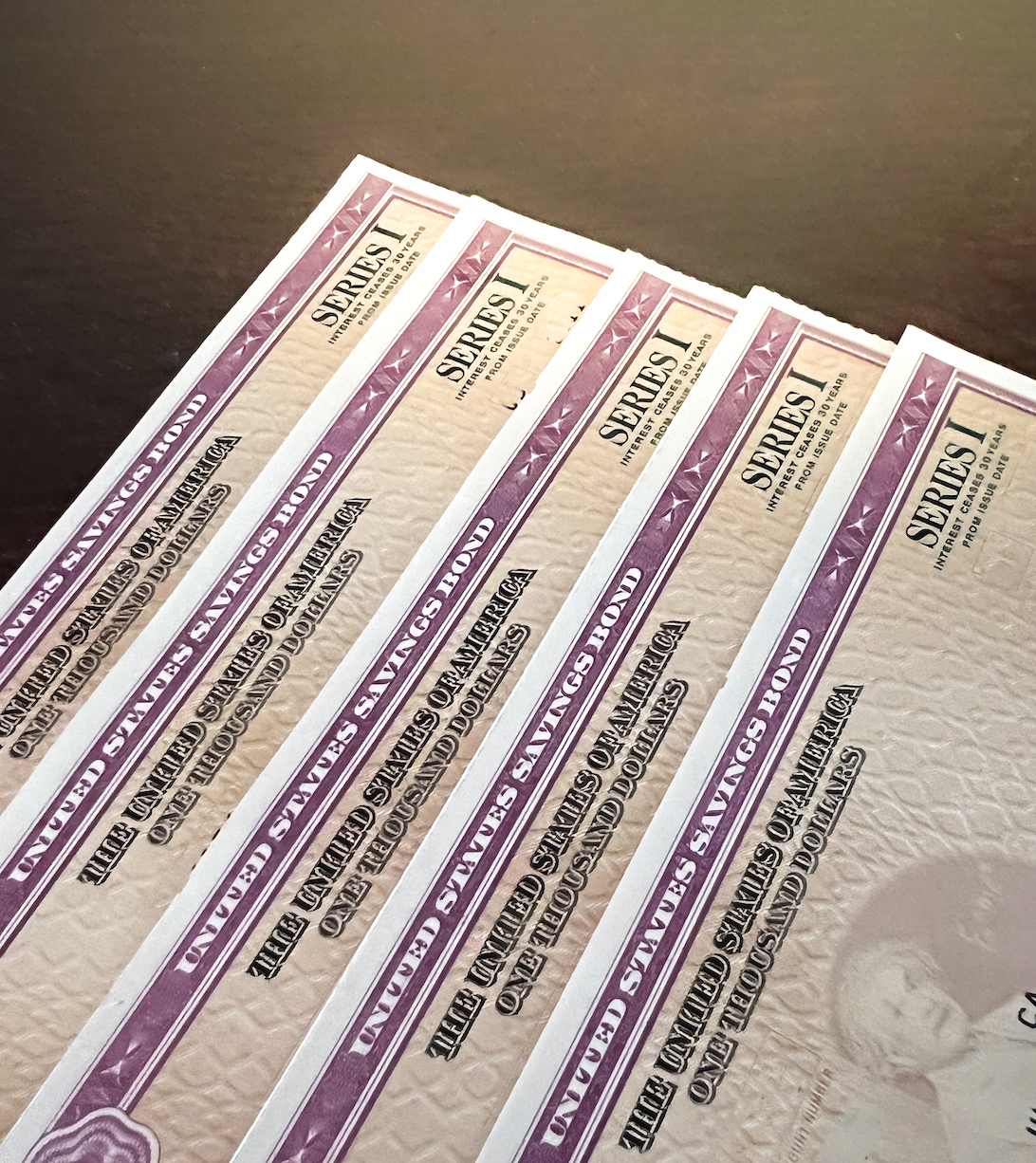
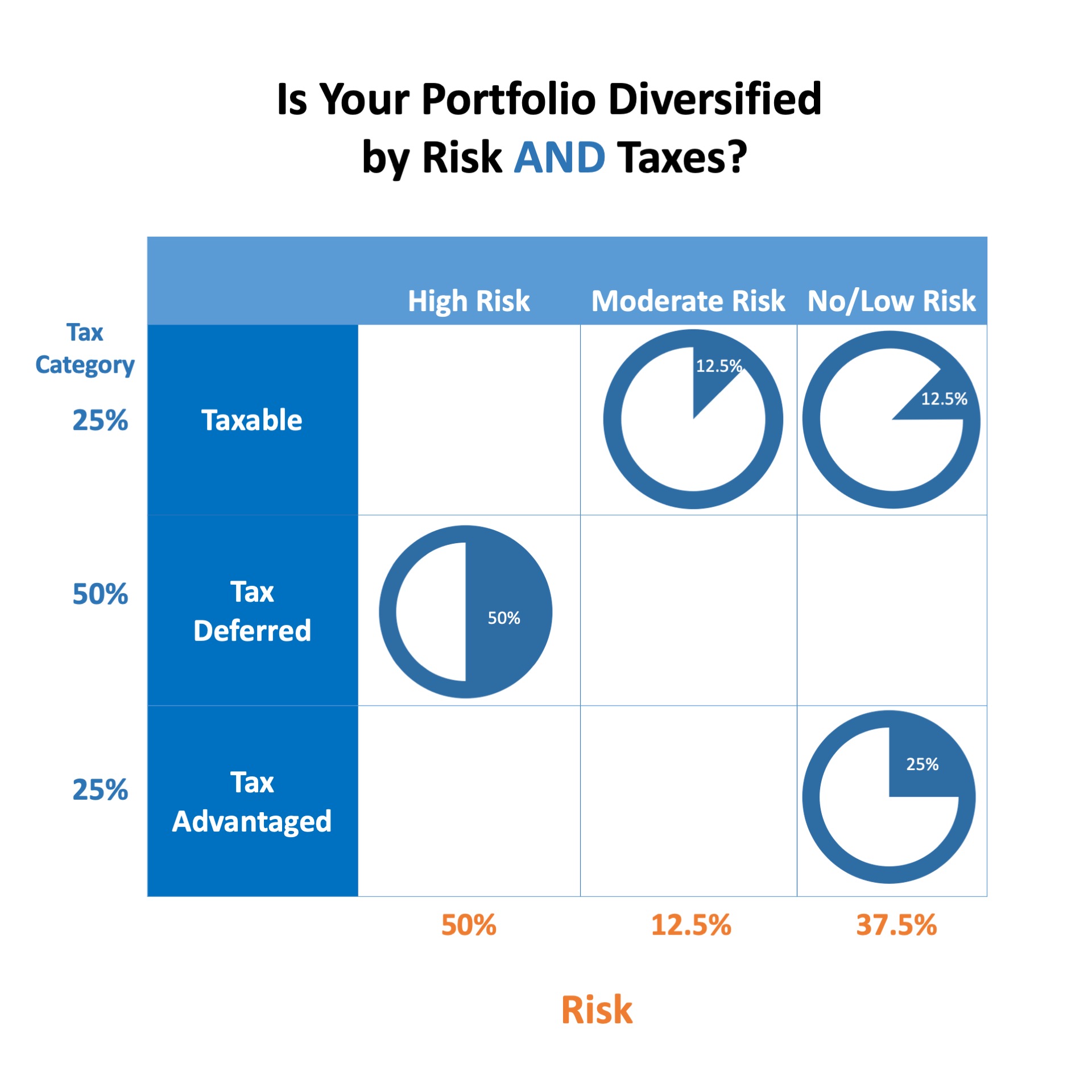
Risk AND Tax Considerations
June 30, 2022
We know the importance of diversifying our portfolio in terms of risk. The younger we are, the more risk we can afford. As we get older, we have less years to weather a recovery, so we need to diversify more towards low risk vehicles.
But did you know that it’s important to diversify your portfolio from a tax perspective? Most of my clients’ portfolios are in their IRA/401Ks, which is tax deferred, not tax free. Stock sand mutual funds that aren’t part of a retirement plan are considered taxable. So are bank savings accounts. There are tax free and no/low risk options..they do exist. Try this exercise on your own portfolio and see how balanced you are from taxes and risk.
Will You Outlive Your Money?
June 23, 2022
The number one question among retirees, and soon-to-be retirees is “will I outlive my money?”. Hopefully you have a plan, and are making projections, accounting for changes to tax laws, spending, etc. There are solutions to get you more “breathing room” so the top line doesn’t go over the columns. The tools go beyond rebalancing your portfolio.
If you would like a projection and see where you are in your retirement plans, contact me for a customized view

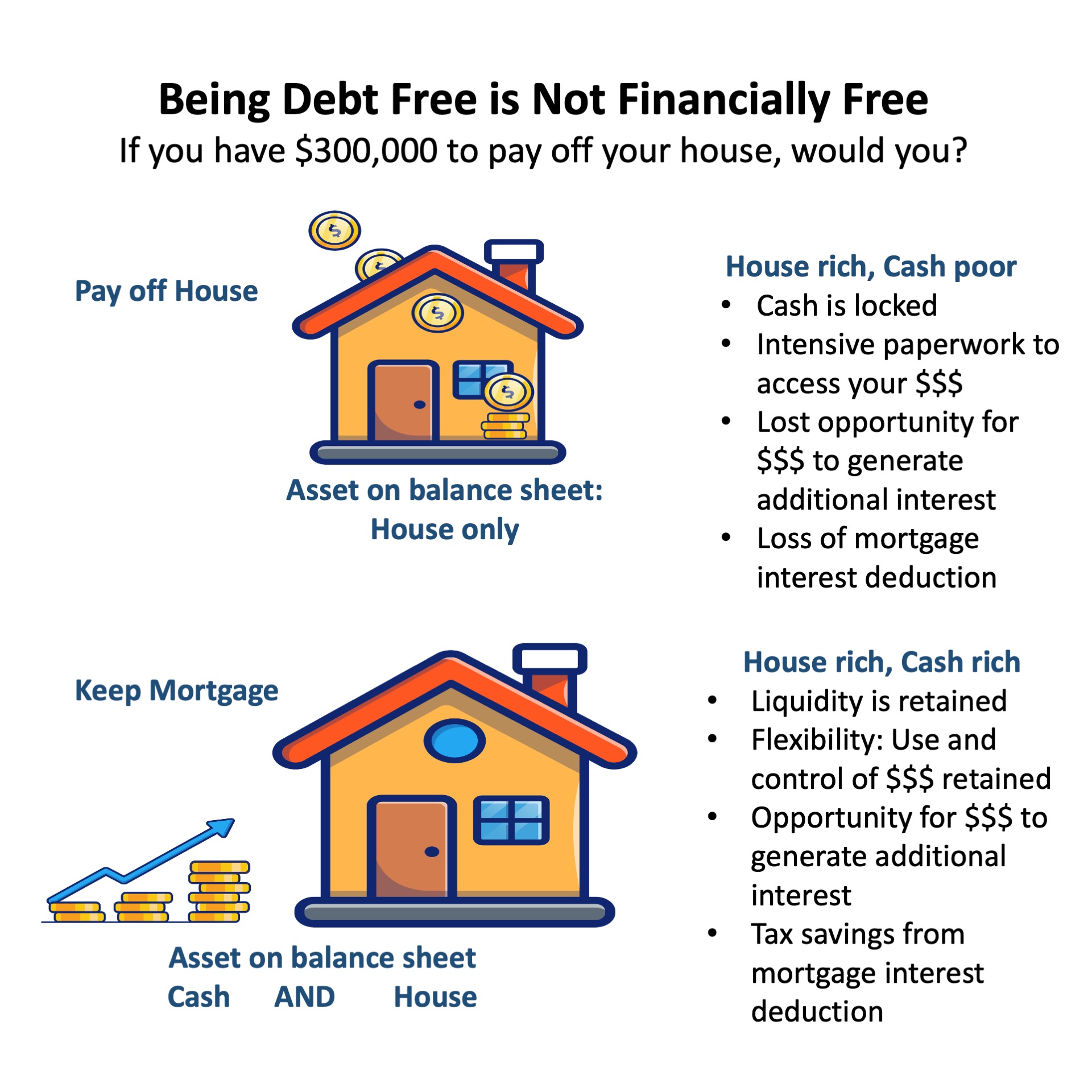
Being Debt Free vs.
Being Financially Free
June 13, 2022
Being debt free is not the same as being financially free. An example of that is by paying off your house. Yes, you don’t have any payments, but you also don’t have liquidity, flexibility, interest generating opportunity, and tax deductions. And trying to tap into your money once it’s sunk in the house requires a lengthy process of income and asset verification –on money you willingly sunk into the home. With a mortgage, you may have payments, but you also have more options.
If you apply for a HELOC to access your money, you have to not only qualify, but you can only borrow up to 80% of the equity. Plus Interest.
Pay Cash or Get a Mortgage
June 1, 2022
Let’s look at how we can pay for a home: cash or take a 30 year mortgage. Let’s also assume both scenarios have the cash to do it. When you pay cash, you give up control of a big chunk of your money.
Sure, you can start to save (using mortgage payment $), but let’s look at doing the reverse. Instead of putting it all in the house, we put the cash to work (conservative 5%). At the end of 30 years, having a mortgage actually puts you almost $300K ahead in your assets.
You get liquidity of your money, tax deduction and use and control. Which scenario truly gives you financial freedom?
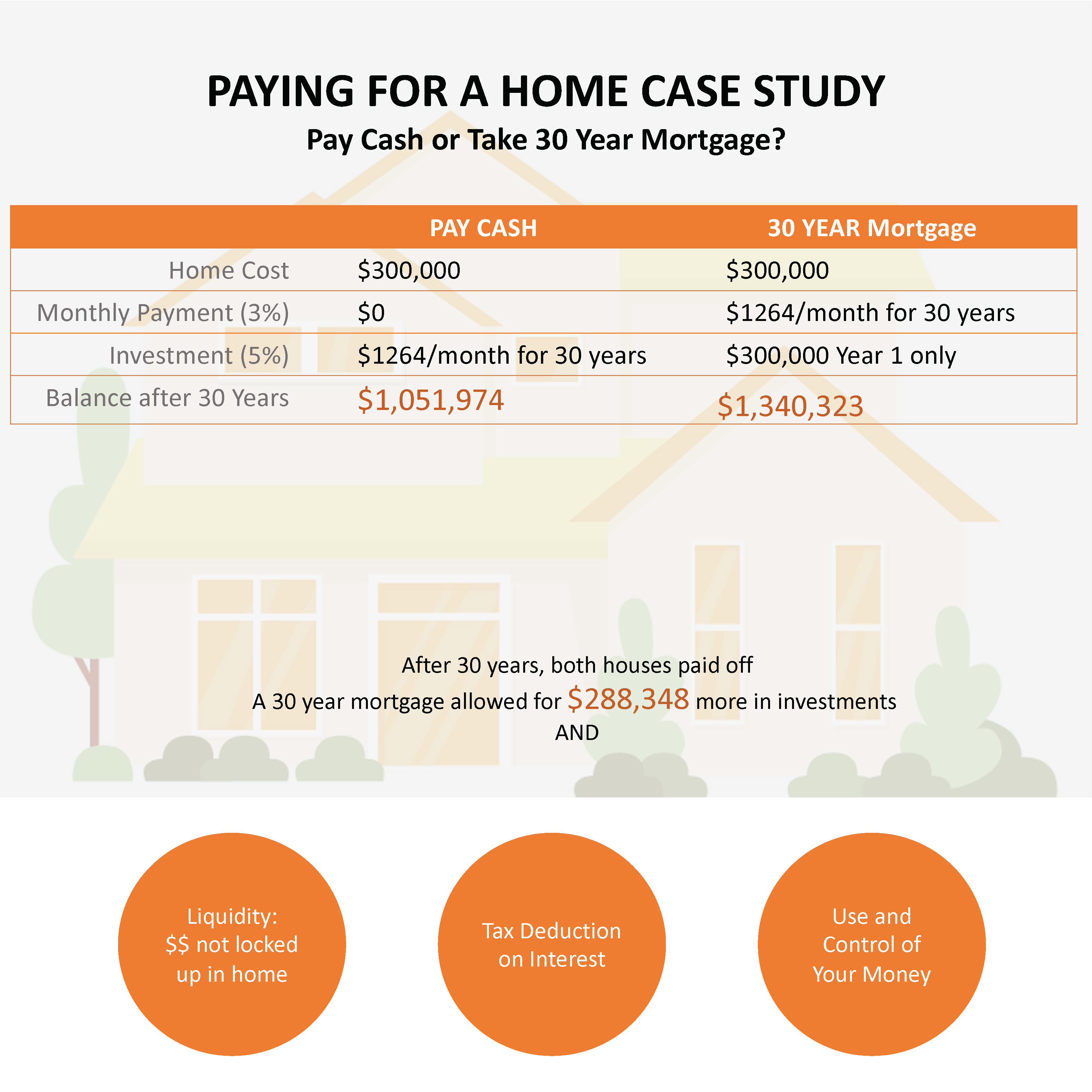

Inherited IRAs Are Bad for You and Your Heirs
May 24, 2022
401Ks, 403Bs, IRAs are great for YOUR retirement but bad as a wealth transfer vehicle.
Due to the SECURE Act, decades of saving on your part will now only have 10 years to be liquidated (and taxes paid) by your non spousal heirs. This could push them up into higher tax brackets, meaning more of your hard earned money will be going to taxes. There are strategies to decrease your IRA balance: Roth conversions, life insurance, direct charitable beneficiaries are just a few.
When doing estate planning, don’t let what you leave behind become a tax burden for your loved ones.
Spender, Saver, or
Wealth Creator?
May 18, 2022
Are you a Spender, Saver, or Wealth Creator? The Spender is always in debt, borrowing money to pay for things, and working to pay off the debt. The Spender is never in a position where money earns interest. The Saver does allow for his money to accrue, but once there is a big purchase (eg. car), the cash is depleted to pay for it and his total balance starts from zero. The The Wealth Creator figures out how to use OPM (Other People’s Money) to pay for things all while allowing his own money to remain liquid and to grow without interruption. If you are a Saver, don’t be in a hurry to pay it all at once…it might serve you to use OPM so that you can become a Wealth Creator.
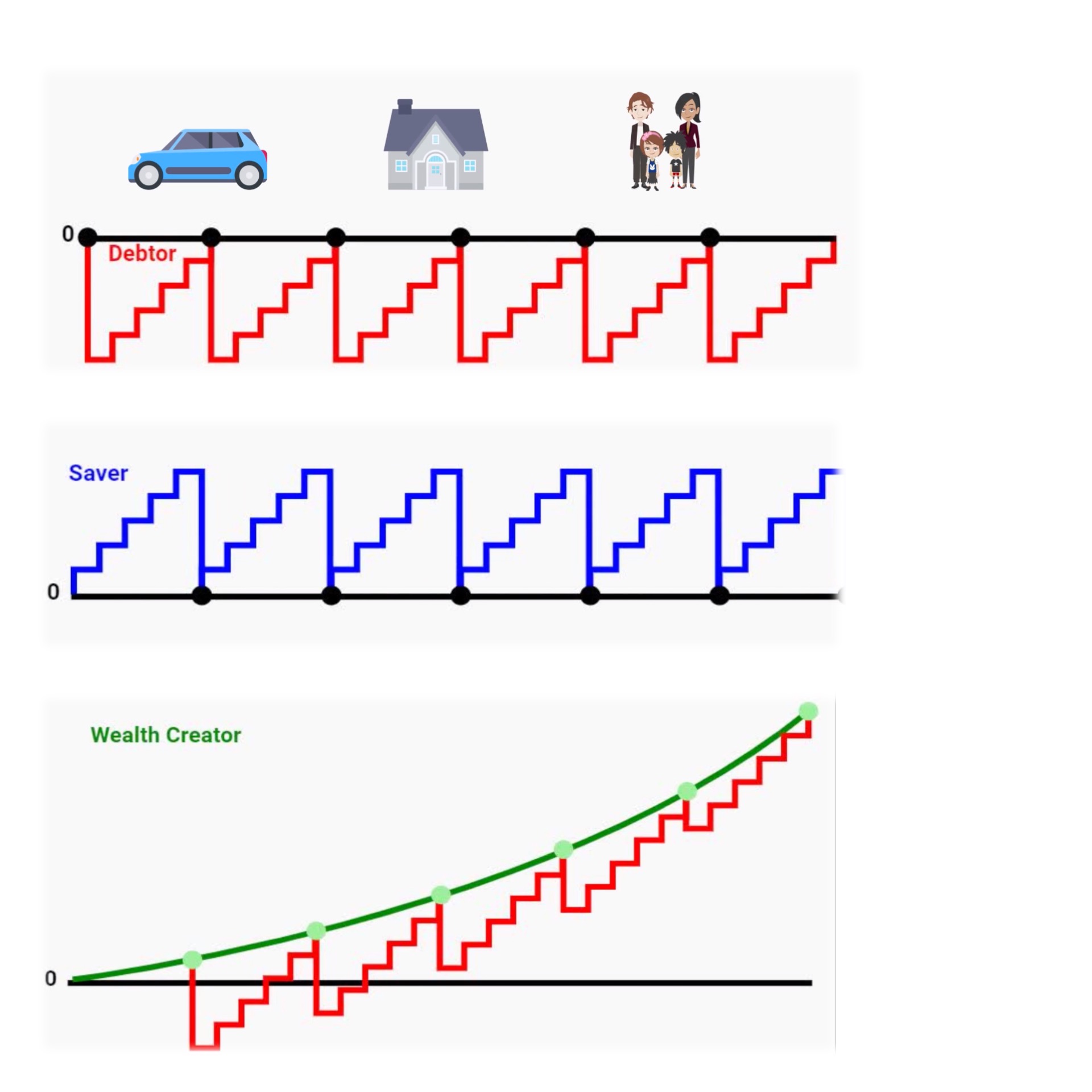
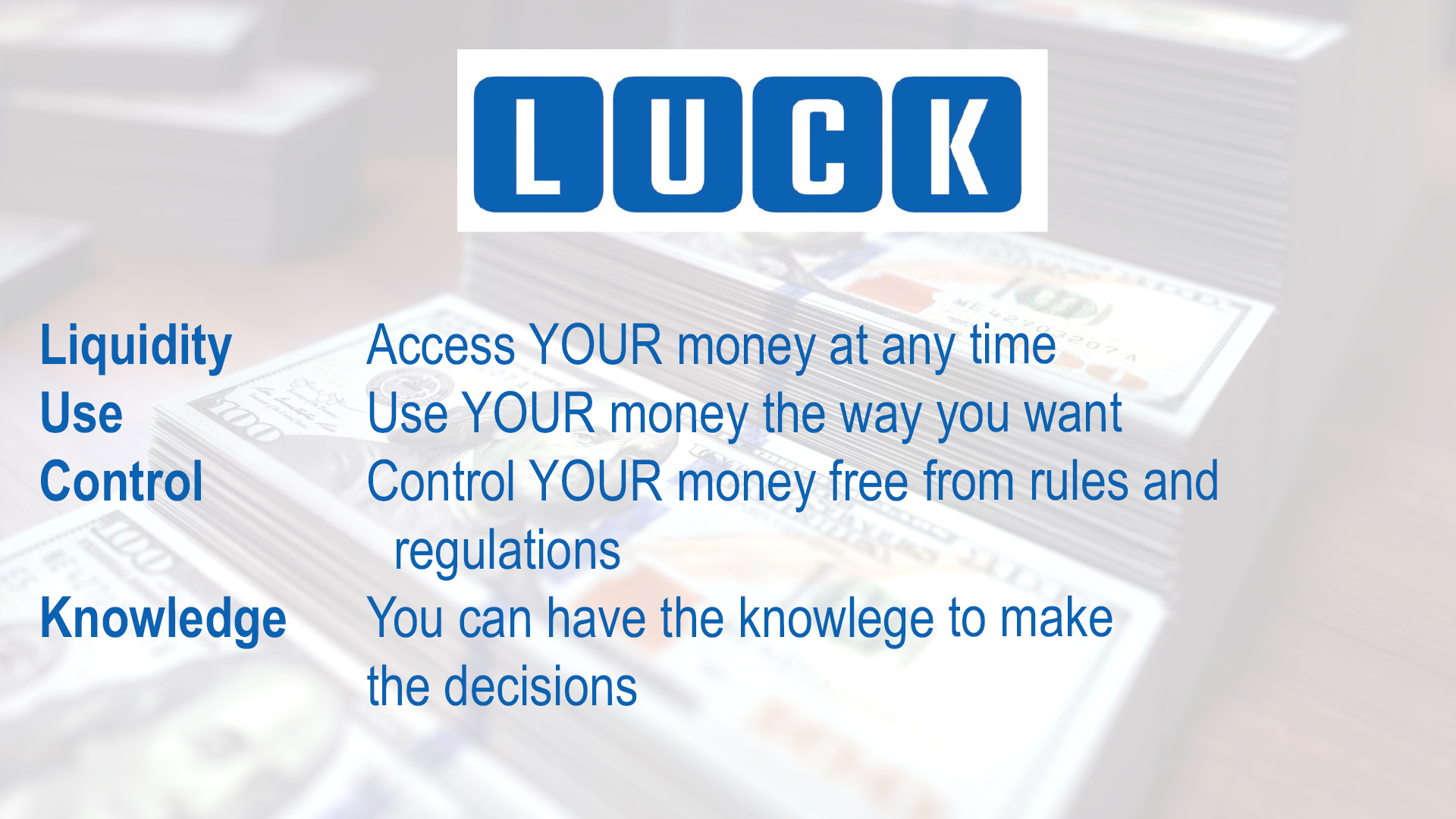
The LUCK Factor
May 11, 2022
When it comes to managing your money, think LUCK:
Liquidity, Use, Control, Knowledge. It seems obvious, but many folks don’t optimize their liquidity. Examples include paying cash for a car or house, or even having a 15 year mortgage. You may save on interest, but you lose on the opportunity cost of having your money earn interest for you. Use and control are about keeping your money free from rules and regulations such as retirement plans or 529 college savings. Yes they are good plans but require careful planning so you don’t leave money on the table. It’s all about optimizing what you have and making it work for you, and not the other way around.
Another Factor for a Balanced Portfolio
May 4, 2022
We often look at our portfolios in terms of risk: what % of my portfolio is in high risk investments and what % is low/no risk investments? But did you know that it’s also important to look at your portfolio in terms of taxes? What percent of your assets are Taxable, Tax Deferred, and Tax FREE? If they are mostly in Taxable and Tax Deferred segments, and Congress raises taxes, you will keep less of your hard earned money. There is a way to increase your share of tax FREE assets. Let’s explore that together.
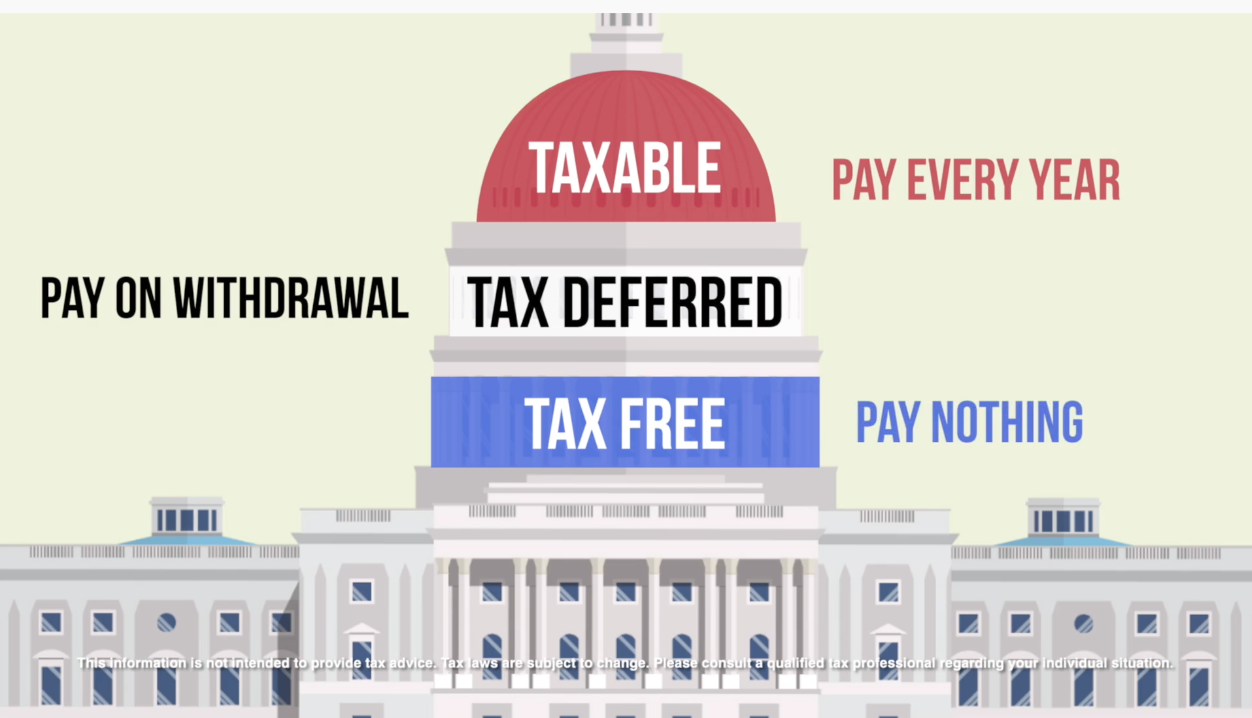
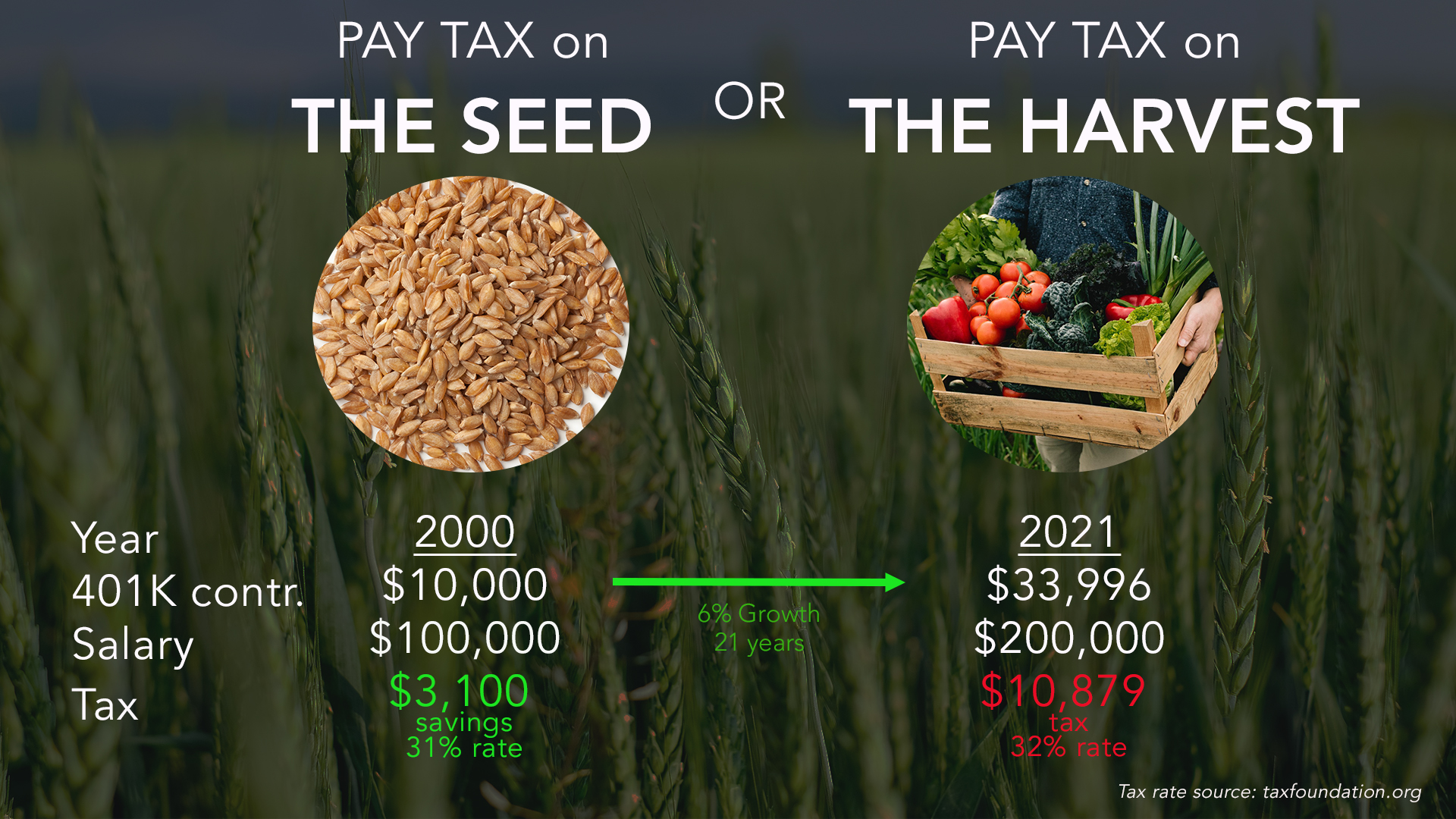
Paying Taxes — On the Seed or the Harvest?
Apr 27, 2022
Did you know that you can overfund your IRA to create a “tax time bomb”?
The most highly utilized retirement savings vehicles tax on the harvest, which can leave those who saved so carefully with much less money than they’d planned on. More of your harvest can be eaten up in taxes if the government decides to raise rates.
Your harvest can be tax advantaged instead of tax deferred.
Tax Deferred is
NOT Tax Free
April 13, 2022
Your 401K, IRA, 403b and other qualified plans have tax obligations, and in some cases as high as 37%. These tax deferred plans are not tax free plans. Fortunately, there are ways to reduce this IOU so any future earnings are tax free.
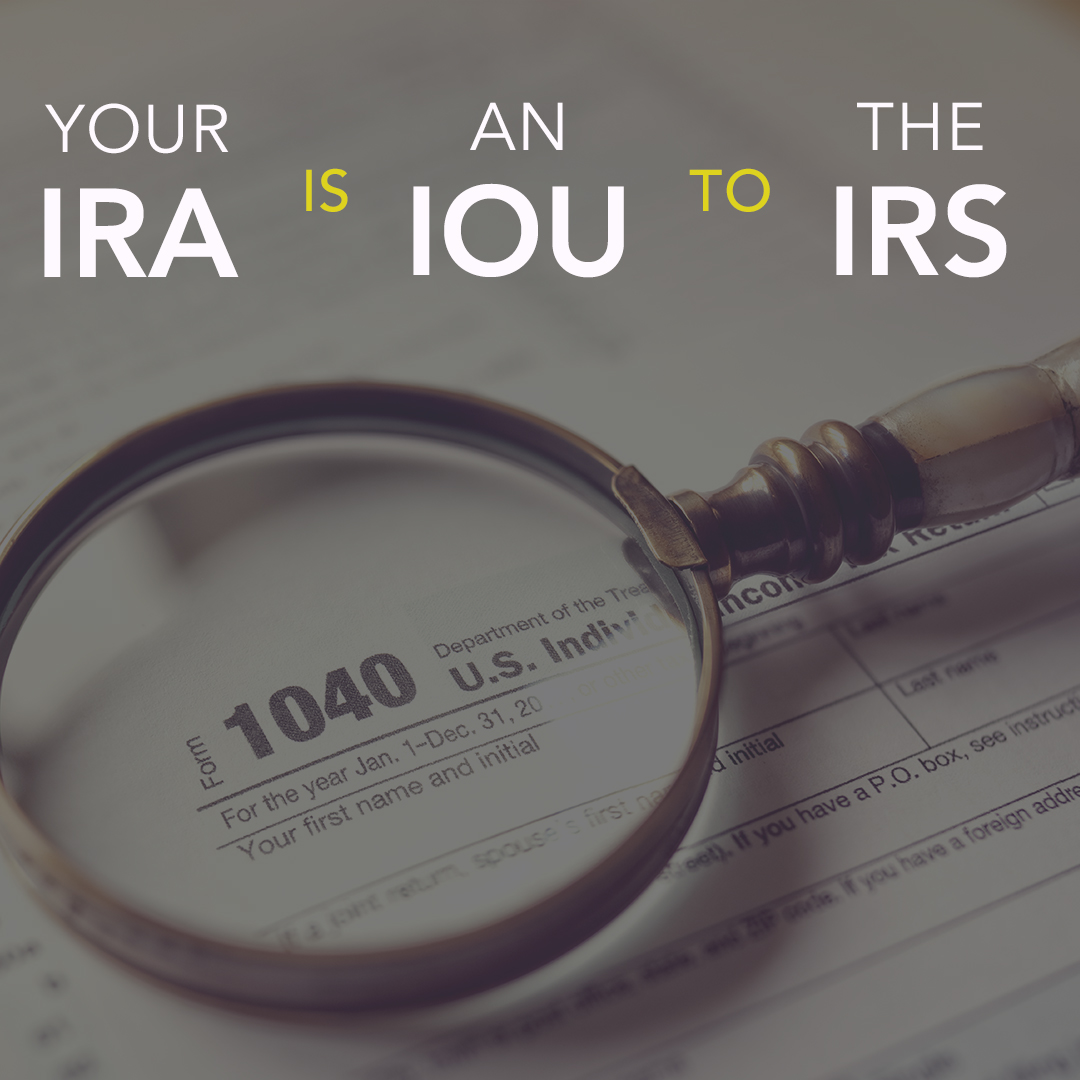
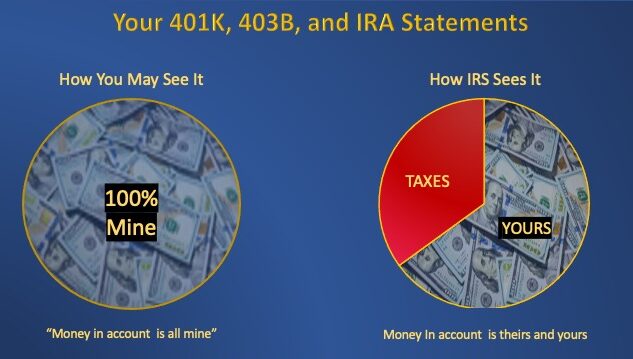
Your Retirement Plan and
your Silent Partner
Apr 5, 2022
As you look at your retirement plan statements, remember to account for taxes. In some cases it can be as high as 37% which can greatly impact your retirement planning. Some clients have discovered that they have to work longer than they planned as their savings won’t go as far. But good news is that there are strategies to mitigate the share your “silent partner” can take.
How Much Risk?
March 28, 2022
How much risk should you have in your portfolio? Here is a guideline. No doubt, as we get older, we need safer investments, as time plays a role in making up for investment losses. Sometimes, there is no more runway to makeup for any losses. As in mileage, your risk tolerance can vary. It’s your personal choice.


